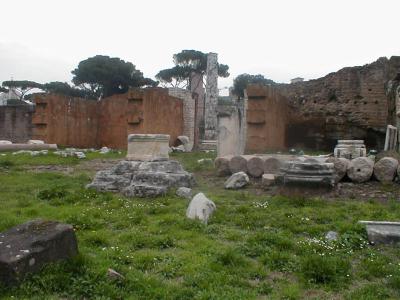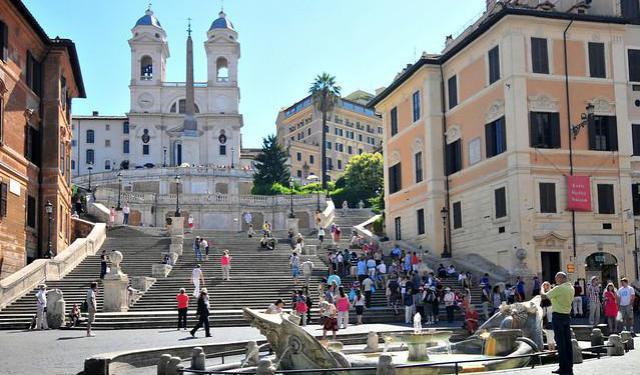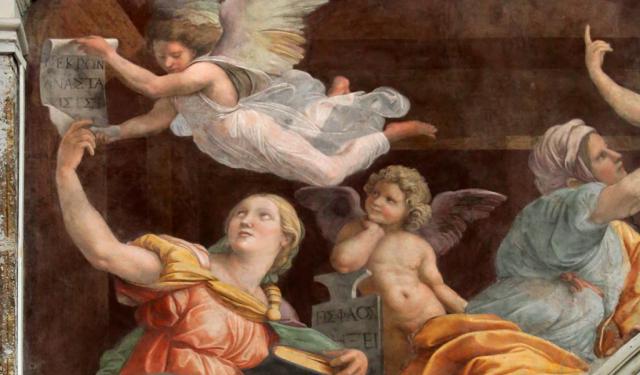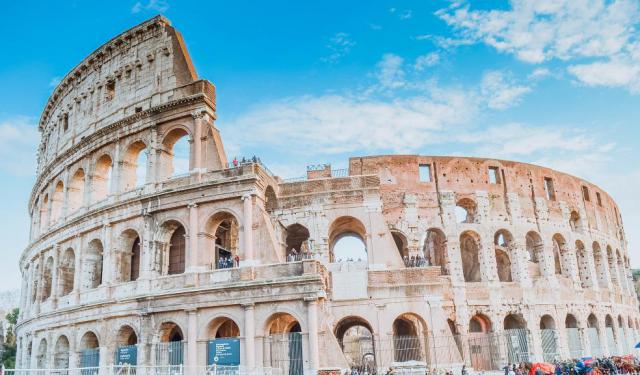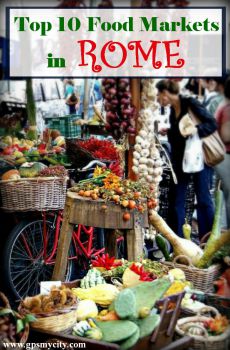Basilica Emilia (Basilica Aemilia), Rome
The Basilica Aemilia, a grand basilica in the Roman Forum, played a crucial role in ancient Rome’s architectural and civic landscape. Although only traces of its foundation and some reconstructed elements remain today, the basilica’s historical significance endures. Measuring 100 meters in length and 30 meters in width, it featured two rows of 16 arches along its sides and had three main entrances, which contributed to its imposing presence.
The basilica was originally constructed in 179 BC by censor Marcus Fulvius Nobilior and was initially called the Basilica Fulvia. However, after Nobilior’s death, his colleague Marcus Aemilius Lepidus took over the project. Over time, it underwent numerous restorations and embellishments by the Aemilian gens, eventually being renamed Basilica Aemilia. Some scholars, however, debate whether the Basilica Fulvia and Basilica Aemilia were distinct structures.
In 55 BC, the building saw a major reconstruction initiated by Lucius Aemilius Lepidus Paullus, a prominent Roman politician. His son completed the renovation in 34 BC, altering the layout by shortening its length and replacing the back portico with a second nave. This version of the basilica showcased a mix of architectural styles, including African marble Corinthian columns in the central nave, cipolline marble columns in the second row, and Ionic capitals in the outermost row.
In 14 BC, a fire led to extensive restoration efforts under Emperor Augustus, who dedicated a new portico to his grandsons, Gaius and Lucius. The basilica’s upper floors were rebuilt, and its attic was adorned with statues of barbarians, emphasizing the grandeur of Roman victory and culture.
However, the basilica met its demise during the 410 AD sack of Rome by Alaric, the first king of the Visigoths. The fire destroyed the wooden roof, façade, and tabernae, leaving behind melted bronze coins that stained the marble floor with green traces. Although a partial reconstruction followed in 420 AD, using pink granite columns for the portico, an 847 earthquake caused its final collapse. The remaining materials were later repurposed for Renaissance buildings, including the Giraud Torlonia Palace.
Throughout its existence, the Basilica Aemilia underwent multiple modifications that reflected the evolution of Roman architecture. Today, although in ruins, it remains a key part of the Roman Forum’s legacy, offering insight into the grandeur of ancient Rome’s civic and architectural achievements.
The basilica was originally constructed in 179 BC by censor Marcus Fulvius Nobilior and was initially called the Basilica Fulvia. However, after Nobilior’s death, his colleague Marcus Aemilius Lepidus took over the project. Over time, it underwent numerous restorations and embellishments by the Aemilian gens, eventually being renamed Basilica Aemilia. Some scholars, however, debate whether the Basilica Fulvia and Basilica Aemilia were distinct structures.
In 55 BC, the building saw a major reconstruction initiated by Lucius Aemilius Lepidus Paullus, a prominent Roman politician. His son completed the renovation in 34 BC, altering the layout by shortening its length and replacing the back portico with a second nave. This version of the basilica showcased a mix of architectural styles, including African marble Corinthian columns in the central nave, cipolline marble columns in the second row, and Ionic capitals in the outermost row.
In 14 BC, a fire led to extensive restoration efforts under Emperor Augustus, who dedicated a new portico to his grandsons, Gaius and Lucius. The basilica’s upper floors were rebuilt, and its attic was adorned with statues of barbarians, emphasizing the grandeur of Roman victory and culture.
However, the basilica met its demise during the 410 AD sack of Rome by Alaric, the first king of the Visigoths. The fire destroyed the wooden roof, façade, and tabernae, leaving behind melted bronze coins that stained the marble floor with green traces. Although a partial reconstruction followed in 420 AD, using pink granite columns for the portico, an 847 earthquake caused its final collapse. The remaining materials were later repurposed for Renaissance buildings, including the Giraud Torlonia Palace.
Throughout its existence, the Basilica Aemilia underwent multiple modifications that reflected the evolution of Roman architecture. Today, although in ruins, it remains a key part of the Roman Forum’s legacy, offering insight into the grandeur of ancient Rome’s civic and architectural achievements.
Want to visit this sight? Check out these Self-Guided Walking Tours in Rome. Alternatively, you can download the mobile app "GPSmyCity: Walks in 1K+ Cities" from Apple App Store or Google Play Store. The app turns your mobile device to a personal tour guide and it works offline, so no data plan is needed when traveling abroad.
Basilica Emilia (Basilica Aemilia) on Map
Sight Name: Basilica Emilia (Basilica Aemilia)
Sight Location: Rome, Italy (See walking tours in Rome)
Sight Type: Attraction/Landmark
Guide(s) Containing This Sight:
Sight Location: Rome, Italy (See walking tours in Rome)
Sight Type: Attraction/Landmark
Guide(s) Containing This Sight:
Walking Tours in Rome, Italy
Create Your Own Walk in Rome
Creating your own self-guided walk in Rome is easy and fun. Choose the city attractions that you want to see and a walk route map will be created just for you. You can even set your hotel as the start point of the walk.
Spanish Steps to Trevi Fountain
An established tourist mecca, today's Rome is hardly imaginable without two of its much loved attractions – the Spanish Steps and the Trevi Fountain. Magnets for tourists as they are, these two sights are connected to a number of other, not less worthy of attention locations, such as the Fountain of the Longboat or Piazza Colonna and its centerpiece, the Column of Marcus Aurelius, to... view more
Tour Duration: 1 Hour(s)
Travel Distance: 2.0 Km or 1.2 Miles
Tour Duration: 1 Hour(s)
Travel Distance: 2.0 Km or 1.2 Miles
Hidden Art Treasures in Rome
Rome is one of the world's top living museums, replete with some of the most iconic pieces of art on the face of the planet. Famous artists, such as Michelangelo, Caravaggio, Raphael, Bernini, to mention but a few, had lived and worked here and left indelible marks in the city.
Needless to say that the abundance of masterpieces makes Rome crowded with tourists anxious to see them, causing... view more
Tour Duration: 1 Hour(s)
Travel Distance: 2.6 Km or 1.6 Miles
Needless to say that the abundance of masterpieces makes Rome crowded with tourists anxious to see them, causing... view more
Tour Duration: 1 Hour(s)
Travel Distance: 2.6 Km or 1.6 Miles
Seven Pilgrim Churches of Rome Walking Tour
Rome has long played host to pilgrims-after all, it's home to the Pope, the Catholic Curia, and a treasure trove of relics linked to apostles, saints, and martyrs. Back in the day, the Via Francigena provided a straight shot for the faithful traveling from England to Rome. Upon arrival, it was tradition to visit the tombs of Saints Peter and Paul. When a Jubilee rolled around, the spiritual... view more
Tour Duration: 6 Hour(s)
Travel Distance: 17.4 Km or 10.8 Miles
Tour Duration: 6 Hour(s)
Travel Distance: 17.4 Km or 10.8 Miles
Rome Introduction Walking Tour I
Often referred to as the Eternal City, Rome holds a unique place in the story of Western civilization. Its influence shaped European culture through language, governance, and monumental architecture.
The name “Rome” originates from Romulus, the mythical founder of the city, who, according to legend, was the son of the war god Mars and Rhea Silvia, the priestess of goddess Vesta. Both... view more
Tour Duration: 2 Hour(s)
Travel Distance: 3.7 Km or 2.3 Miles
The name “Rome” originates from Romulus, the mythical founder of the city, who, according to legend, was the son of the war god Mars and Rhea Silvia, the priestess of goddess Vesta. Both... view more
Tour Duration: 2 Hour(s)
Travel Distance: 3.7 Km or 2.3 Miles
Vatican Walking Tour
Consisting of a walled enclave within the city of Rome, the Vatican is the world’s smallest sovereign state, as well as a symbol (and headquarters) of the Roman Catholic faith. Although only 44 hectares in surface, one is amazed by the vastness of this place and the sheer size of everything. When gazing around in all directions, you realize how much can be achieved by people working in faith for... view more
Tour Duration: 2 Hour(s)
Travel Distance: 3.4 Km or 2.1 Miles
Tour Duration: 2 Hour(s)
Travel Distance: 3.4 Km or 2.1 Miles
Trastevere Walking Tour
Heading down from the Vatican along the River Tiber, one is bound to find yet another city hidden within the city – Trastevere. This name translates literally to "across the Tiber". Indeed, crossing the picturesque Ponte Sisto (Sisto Bridge) to the west bank, you will find yourself in a charming neighborhood with a distinct character that sets it apart from any other part of Rome.
... view more
Tour Duration: 2 Hour(s)
Travel Distance: 3.0 Km or 1.9 Miles
... view more
Tour Duration: 2 Hour(s)
Travel Distance: 3.0 Km or 1.9 Miles
Useful Travel Guides for Planning Your Trip
17 Best Gelaterias in Rome Italy
For ice cream lovers and dabblers this guide is a treasure chest of Rome’s best gelato shops. There are gelaterias everywhere. Many visitors to Rome only have a few days to explore the city. You owe it to yourself to make the most of your time and find the gelato locals eat. Often the authentic...
Souvenirs Shopping: 15 Authentic Italian Things To Buy in Rome
Rome is the Eternal City and, as such, the list of gift options available here is countless. Whether it's something edible, drinkable, wearable or pleasing to the eye that you want - you will find it all here in abundance. However, if time or budget is the factor, perhaps you might want to...
10 Best Food Markets in Rome Italy
Of all the things Italy is most famous for (cars, music, fashion, movies, etc.), food is, undoubtedly, top of the list. Rome may well not be the whole Italy, but no Italy is whole without Rome... And the Romans, much as all their fellow-Italians, like it "fresco", hence the abundance of...
